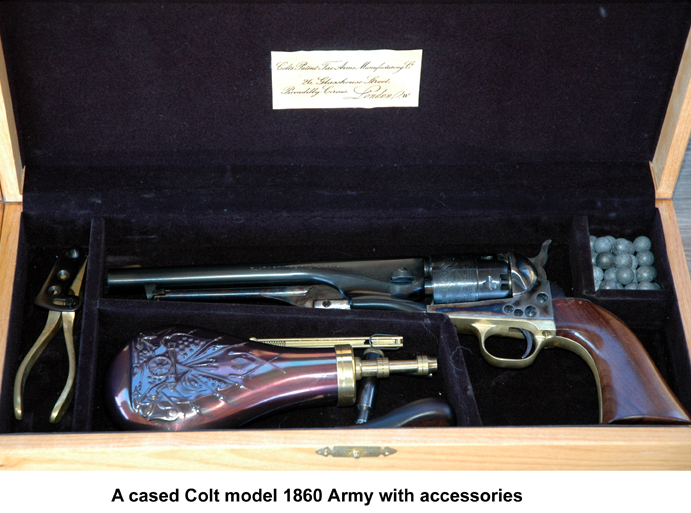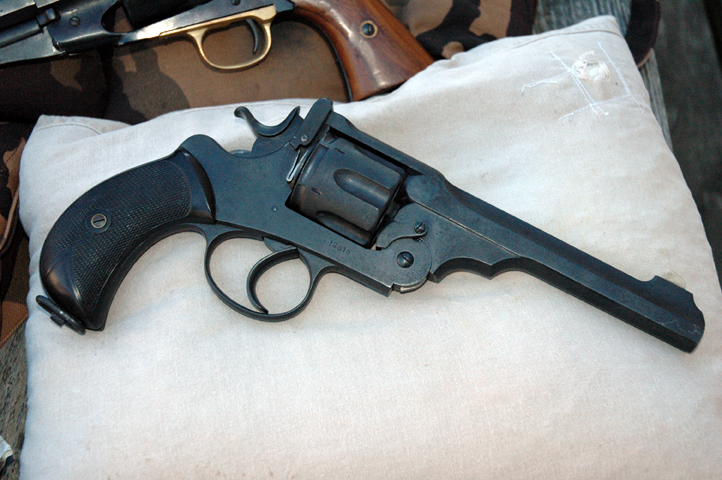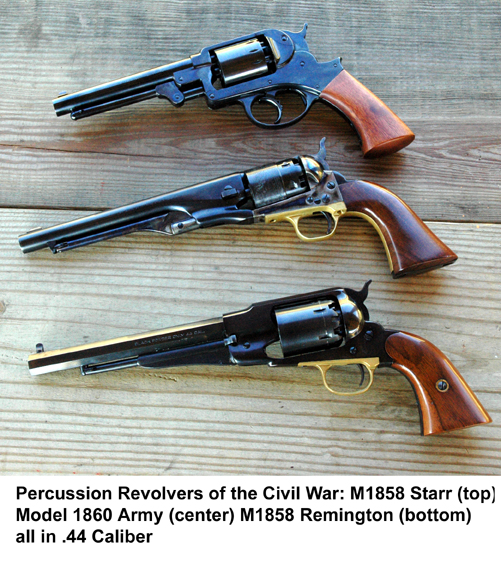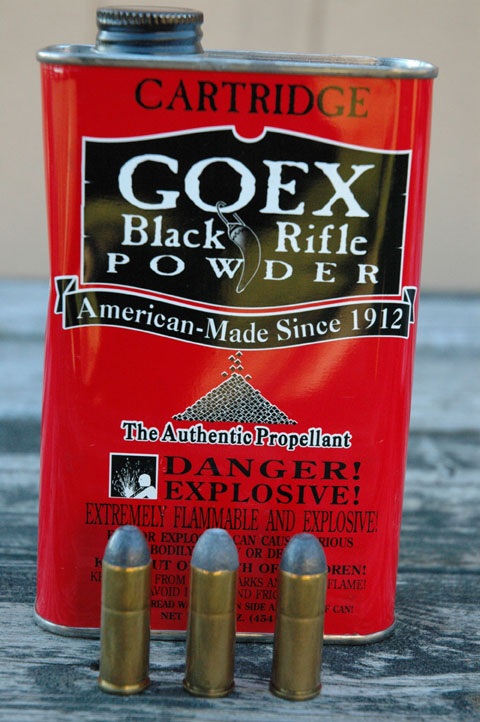HOW GOOD WAS BLACK POWDER?
Modern-day handgunners, a pretty practical lot, think in modern-day terms most of the time. The “performance numbers” for handguns and their ammunition published in magazine articles show a clear trend towards higher and higher velocities and energies. This is a response to the shooting public’s general perception that “faster is better” when it comes to handgun effectiveness.
But it’s also been my observation that shooters tend to be prone to a bit of nostalgia. At one time or another I think we all visualize ourselves in some sort of romanticized role: how else to explain the wildfire-like spread of the “Cowboy Action” shooting game? Why do grown men dress in the clothes and carry the weapons of the famous lawmen and gunmen of Yesteryear, if not because secretly they can see themselves—presumably on the side of Law and Order—shooting it out on the streets of Dodge City or Tombstone?
 The historical records (and the somewhat less reliable legends) of the Good Old Days tend to leave no doubt that when The Good Guys and The Bad Guys did settle disputes with sidearms, the end results were often lethal, but there isn’t all that much objective information available on just how effective those old “hawg-legs” they packed were in comparison to modern firearms. Leaving aside the question of how many gunshot victims of the 1880’s died of blood poisoning and infection versus those who were dropped in their tracks by The Marshall’s Trusty Sixshooter, it’s possible to make some direct performance comparisons today.
The historical records (and the somewhat less reliable legends) of the Good Old Days tend to leave no doubt that when The Good Guys and The Bad Guys did settle disputes with sidearms, the end results were often lethal, but there isn’t all that much objective information available on just how effective those old “hawg-legs” they packed were in comparison to modern firearms. Leaving aside the question of how many gunshot victims of the 1880’s died of blood poisoning and infection versus those who were dropped in their tracks by The Marshall’s Trusty Sixshooter, it’s possible to make some direct performance comparisons today.
As a collector and shooter of original and replica old-time handguns, and a black powder aficionado, I am naturally interested in this question; as a scientist I have some modest skill in data collection and interpretation of observations. So I put these two together, and looked at how the guns of Yesteryear stack up against those of today. The short answer is: not badly at all. For this article I chose five big-bore handguns, representatives of the percussion and early metallic-cartridge era. These are shown above.
 Two of them are replicas of guns widely used in the relatively short period when percussion ignition was the only practical system for repeating handguns: a Colt Model 1860 Army .44, and its direct competitor, Remington’s Model 1858 New Army .44. Both these large revolvers were widely used in the American Civil War and in the post-war period of frontier settlement. Both were sold around the world and achieved a great deal of popularity in other areas being “civilized” in the 1860’s and 1870’s. Many famous Good Guys and Bad Guys carried one (or both) of these big guns and not a few arguments were concluded with them.
Two of them are replicas of guns widely used in the relatively short period when percussion ignition was the only practical system for repeating handguns: a Colt Model 1860 Army .44, and its direct competitor, Remington’s Model 1858 New Army .44. Both these large revolvers were widely used in the American Civil War and in the post-war period of frontier settlement. Both were sold around the world and achieved a great deal of popularity in other areas being “civilized” in the 1860’s and 1870’s. Many famous Good Guys and Bad Guys carried one (or both) of these big guns and not a few arguments were concluded with them.
As a “yardstick” to use in measuring the performance of these percussion stalwarts, I chose a Ruger Old Army .45 revolver. The Old Army is the lineal descendant of the Model 1858 Remington. A solid-frame design updated with modern materials and engineering, the Old Army is strongest and most accurate percussion revolver ever built. If self-contained ammunition had never been invented, the Old Army would probably have evolved as the very pinnacle of handgun development. All three of these revolvers have 7-1/2” barrels.
To represent the handguns of the post-percussion period I chose two genuine antiques, both very likely used more than once for their original purposes. One of them, a Webley-Green Army Model 1894, saw active service in the Boer War, and perhaps in various actions before and after that conflict. The second is a Webley #5 Frontier Double Action.
 The Webley-Green (affectionately known as the “W-G”) was not a military-issue weapon, but it was acceptable for military use and very popular with British officers (who were required to purchase their own sidearms). Mine is marked "ARMY-NAVY C.S.L." to indicate that it was retailed through the Cooperative Services League. This revolver has a 6” barrel and was made about 1894-1895. It traveled to South Africa in the personal baggage of some officer posted there; I'd be very surprised if it wasn't fired in anger during the Boer War, given its age and indisputable military provenance. I bought this revolver from Classic Arms in Witbank, South Africa: it has been refinished with a matte black resembling Parkerizing; it's tight and in good shape, with a decent bore. The big top-break W-G’s were highly regarded for their accuracy and as formidable man-stoppers. M1894 Army W-G’s marked ".455/.476" will chamber and fire .45 Long Colt; some W-G's were originally produced in .45 Long Colt for civilian sales. They can also be shot with the .450 Boxer and .455 Webley round, of course.
The Webley-Green (affectionately known as the “W-G”) was not a military-issue weapon, but it was acceptable for military use and very popular with British officers (who were required to purchase their own sidearms). Mine is marked "ARMY-NAVY C.S.L." to indicate that it was retailed through the Cooperative Services League. This revolver has a 6” barrel and was made about 1894-1895. It traveled to South Africa in the personal baggage of some officer posted there; I'd be very surprised if it wasn't fired in anger during the Boer War, given its age and indisputable military provenance. I bought this revolver from Classic Arms in Witbank, South Africa: it has been refinished with a matte black resembling Parkerizing; it's tight and in good shape, with a decent bore. The big top-break W-G’s were highly regarded for their accuracy and as formidable man-stoppers. M1894 Army W-G’s marked ".455/.476" will chamber and fire .45 Long Colt; some W-G's were originally produced in .45 Long Colt for civilian sales. They can also be shot with the .450 Boxer and .455 Webley round, of course.
 The Webley #5 Frontier is a real saloon brawler’s gun: a compact, powerful belt pistol dating from about 1878. My reference books say that a shipment of #5’s was sent to the old
The Webley #5 Frontier is a real saloon brawler’s gun: a compact, powerful belt pistol dating from about 1878. My reference books say that a shipment of #5’s was sent to the old
The M1858 and M1860 were used with 140-grain round balls, a lubricated wool "Wonder Wad" between the powder and ball, and #11 percussion caps. The charge was a nominal 30 grains of GOEX FFFg black powder, measured volumetrically from a CVA flask. The Ruger used this same powder charge under a 240-grain conical bullet. I only shot this with conical bullets, as I lacked the round balls of the proper diameter for it (the OA uses .457" balls, I had only 0.451" for the .44's).
When using BP as a propellant, bullet weight is a major factor in assessing performance. Round balls are pretty anemic, even though velocities were respectable: 640 fps for the M1858 and 824 fps in the M1860. A lead ball is the lightest possible projectile for any given diameter. For a .44 caliber gun it weighs only 140 grains. The energy developed with a round ball was barely in the .38 Special class: 130 and 227 f-p respectively. The Colt’s velocities were a shade better than those in the Remington, despite an equivalent barrel length, perhaps due to a tighter barrel-cylinder gap, or some other vagaries of manufacture.
 Percussion ignition actually had a fairly short life as state-of-the-art firearms technology: once self-contained ammunition became a practical alternative (beginning in 1857 with S&W's introduction of the .22 Short) and especially after 1872 (with expiration of Rollin White's 1854 patent that gave S&W a monopoly on cylinders bored through from the rear to accept cartridges) percussion guns were rapidly replaced by those using fixed ammuniton. It was a common practice in the early post-percussion era to modify existing revolvers to take advantage of the new self-contained ammunition: many such post-manufacture conversions of Colt and Remington revolvers were done. Most of these conversions were "reversible" (some weren't) and the frame could be used with the new ammunition or with loose powder and ball; naturally there was a lot of "overlap" between 1872 and about 1890; but until well into the 20th Century, even when using fixed ammunition, black powder was a standard propellant.
Percussion ignition actually had a fairly short life as state-of-the-art firearms technology: once self-contained ammunition became a practical alternative (beginning in 1857 with S&W's introduction of the .22 Short) and especially after 1872 (with expiration of Rollin White's 1854 patent that gave S&W a monopoly on cylinders bored through from the rear to accept cartridges) percussion guns were rapidly replaced by those using fixed ammuniton. It was a common practice in the early post-percussion era to modify existing revolvers to take advantage of the new self-contained ammunition: many such post-manufacture conversions of Colt and Remington revolvers were done. Most of these conversions were "reversible" (some weren't) and the frame could be used with the new ammunition or with loose powder and ball; naturally there was a lot of "overlap" between 1872 and about 1890; but until well into the 20th Century, even when using fixed ammunition, black powder was a standard propellant.
To cover this transitional period both the Old Army and the Model 1858 used for this article were equipped with conversion cylinders made by Taylor’s Manufacturing of Winchester Virginia, according to a basic design dating from the 1870’s. (It should be noted that the groove diameter for “.44” caliber percussion revolvers is in fact 0.450” so they can be used with .45 Colt ammunition. Taylor’s warns not to use heavy loads of smokeless powder, though their cylinders are safe with the “Cowboy Action” level smokeless loads available from several ammunition makers.) My "yardstick" cartridge load was Remington’s .45 Long Colt commercial product. This has a 250-grain hollow base lead RNFP bullet, nominally rated at 860 fps and 410 fp of muzzle energy. I fired it from the Ruger, the M1858, and the W-G.
Out of the Ruger, using the same bullet Remington loads in its commercial product, I achieved 858 fps and 412 fp; close enough to factory specs. From the Remington it gave me 846 fps and 403 fp. So in guns with equivalent barrel lengths, this load performed as expected. I also used as a comparison a "Cowboy Action" reload using a 225-grain LRN originally designed for .45 ACP over 8.5 grains of Alliant’s Unique. I was a little surprised to find that in the Ruger Old Army this load outperformed the factory stuff, averaging 1009 fps and 509 fp! From the W-G’s 6” barrel it went out at 852 fps for 363 fp. A very respectable performance and not the least bit unpleasant to shoot.
 Of course, the .45 Long Colt (introduced in 1873 and never since out of production) was originally loaded with black powder. Factory loads of that time used 40 grains of FFFg and the same 250-grain lead flat-point round-nosed bullet. It was rated at 810 fps, and the current production smokeless ammunition is ballistically identical to that old BP loading.
Of course, the .45 Long Colt (introduced in 1873 and never since out of production) was originally loaded with black powder. Factory loads of that time used 40 grains of FFFg and the same 250-grain lead flat-point round-nosed bullet. It was rated at 810 fps, and the current production smokeless ammunition is ballistically identical to that old BP loading.
It is impossible to get that much black powder into a modern case. Black powder is an inefficient propellant, and to achieve decent velocities you need a fair amount of  it. The old cases were the "balloon head" type with a good deal more interior volume than modern ones. In balloon head cases the base is thinned to increase the interior volume as much as possible: the primer pocket actually is inside a small raised portion in the head that looks like a "hill" in the center. Modern cases have much thicker brass in the head, but the loss of interior volume is unimportant because smokeless powder is so much more "energy dense" than BP. The thicker head has the advantage of greater strength than the old balloon-head type.
it. The old cases were the "balloon head" type with a good deal more interior volume than modern ones. In balloon head cases the base is thinned to increase the interior volume as much as possible: the primer pocket actually is inside a small raised portion in the head that looks like a "hill" in the center. Modern cases have much thicker brass in the head, but the loss of interior volume is unimportant because smokeless powder is so much more "energy dense" than BP. The thicker head has the advantage of greater strength than the old balloon-head type.
It's possible to get the original BP levels of performance in solid head cases with "replica" BP, such as Pyrodex.  Pyrodex “P” grade is sold for use in percussion revolvers, but my experience with it in them isn't good: it's more difficult to ignite than genuine BP so that hang-fires and long lock times are the rule in my guns. Although I've abandoned its use in percussion guns entirely, I've found it to be wonderful stuff when used in loading BP cartridges. In this situation it really shines: the hotter primer flame gives 100% reliable ignition, no hangfires, and extraordinarily uniform velocities. It meters beautifully, and I can't praise it enough as a substitute for BP for such uses.
Pyrodex “P” grade is sold for use in percussion revolvers, but my experience with it in them isn't good: it's more difficult to ignite than genuine BP so that hang-fires and long lock times are the rule in my guns. Although I've abandoned its use in percussion guns entirely, I've found it to be wonderful stuff when used in loading BP cartridges. In this situation it really shines: the hotter primer flame gives 100% reliable ignition, no hangfires, and extraordinarily uniform velocities. It meters beautifully, and I can't praise it enough as a substitute for BP for such uses.
Pyrodex is only about 80% as dense as real BP. It's usually measured by volume, as BP is; but if you use a volumetric measure marked "40 grains" designed for BP and then actually weigh the Pyrodex charge, you find it's about 32 grains in weight. Thanks again to the difference in balloon head and solid head cases, it's difficult to get even that 32 grains into a modern case, especially if the bullet is to be seated fairly deep. But 25 grains (by weight) of Pyrodex P has about the same volume as 32 grains of BP, and will give the same ballistics. Given the variables involved, and the fact that it's being used in a solid case (which produces higher pressures with smaller charges) this is quite enough to duplicate factory BP ballistics. My Pyrodex loads used Lyman’s #454424 cast semi-wadcutter hunting bullet weighing 250 grains. I could load it to an OAL that was short enough to be used in the conversion cylinders for the Ruger and the M1858, as well as in the two Webleys.
 I did load some ammo with real BP. These were made up with GOEX "Cartridge" grade BP, under the same bullet used in the Remington factory loads. The most I could get into the case with room to seat this bullet at all was 29 grains, and even then the OAL was too long for the conversion cylinders in the Ruger and M1858. They did fit the Webleys, though, and were used in those two guns.
I did load some ammo with real BP. These were made up with GOEX "Cartridge" grade BP, under the same bullet used in the Remington factory loads. The most I could get into the case with room to seat this bullet at all was 29 grains, and even then the OAL was too long for the conversion cylinders in the Ruger and M1858. They did fit the Webleys, though, and were used in those two guns.
Using the conversion cylinder on the M1858 gave significantly higher velocities, even with heavier projectiles, than the percussion cylinder. This is due to the far more efficient gas seal a cartridge case provides compared to a percussion nipple. A percussion revolver's chamber is tenuously sealed at the moment of ignition by the soft copper cap and the inertia of the hammer: but obturation in percussion guns is a fleeting phenomenon at best. Firing a percussion revolver in dim light reveals that significant gas leakage from the nipple occurs, quite enough to account for that difference in velocity. If the invention of the self-contained cartridge had achieved nothing else, the performance boost it gave compared to percussion ignition would have justified its existence. It’s no wonder that retro-fitting percussion guns to use cartridges was a commercial success in the post-1873 period. Even though such conversions are pretty crude, they are much faster to reload than a percussion cylinder and give significantly higher performance even with black powder.
 I've been saving the best for last: the two Webleys. Both these old warhorses have cylinders a good bit longer than the one on the Ruger, so I was able to shoot my CTG reloads, as well as the Pyrodex loads using the wadcutter bullet. I wasn't willing to pop off any smokeless powder in the #5, but I did shoot some of the Unique reloads in the W-G.
I've been saving the best for last: the two Webleys. Both these old warhorses have cylinders a good bit longer than the one on the Ruger, so I was able to shoot my CTG reloads, as well as the Pyrodex loads using the wadcutter bullet. I wasn't willing to pop off any smokeless powder in the #5, but I did shoot some of the Unique reloads in the W-G.
The #5 shot the heavy Lyman wadcutter at an average of 788 fps for 350 fp of energy, and the 255 grain Remington lead RN a shade slower, for 740/308. This compares very favorably to the Ruger's data, given the 2-1/2" difference in barrel length.
The W-G, which is one of the most finely-crafted revolvers I've ever owned, did even better with its 6" barrel: with the Lyman bullet, it averaged 819 fps and 377 fp; and with the round nose Remington bullet, even with a substantially smaller charge, achieved 764 fps and 328 fp. These are comparable in performance to the .45 ACP!
So to sum up, the answer to the question "How Good was Black Powder?" is: "Not half bad!" Certainly when used with conical bullets, any of these guns would be effective against man-sized animals. They surely did earn their reputations as reliable defense rounds in the "Good Old Days" with ballistics like these. Though the velocities are low compared to those expected from modern handguns, the final results of being hit by one of those fat chunks of lead loping along at a leisurely 700 fps would assuredly be unpleasant, and not infrequently fatal. The bad men and lawmen of old times were well served.
A big-bore BP revolver would be a viable self-defense weapon, especially as a house gun, though it would be...umm...well, unpleasant to shoot indoors. It would create a smokescreen of considerable density! But there is no question in my mind that it would work, especially if you used a conversion cylinder.
There is much looser regulation of replicas and legally defined antiques under the Federal law and in most state codes which may be another consideration. The federal Gun Control Act of 1968 and its regulations specifically exempts "antiques" from all regulation, and defines antiques in such a way as to include any percussion-fired handgun using loose powder and ball, regardless of date of manufacture. Any firearm made before 1 January 1899 is also legally an antique and exempt from regulation. Most states have adopted similar or identical definitions of antiques (not all!) and such guns can be purchased without a lot of paperwork. The conversion cylinders are not regarded as "firearms" by the Feds either. An new-made Ruger Old Army can be purrchased without fuss, and fitted with a cylinder for your individual use quite legally as far as Federal law is concerned.
Some states regard antiques in the same way as "modern" guns and some don't; it's necessary to check local laws, especially if you live in a gun-unfriendly place like New York, New Jersey, Illinois, and the District of Columbia.
| HUNTING | GUNS | DOGS |
| FISHING & BOATING | TRIP REPORTS | MISCELLANEOUS ESSAYS |
| CONTRIBUTIONS FROM OTHER WRITERS|
| RECIPES |POLITICS |